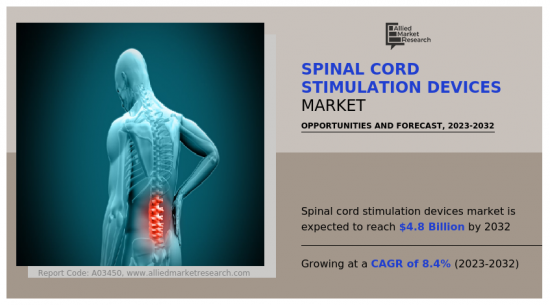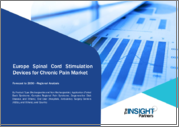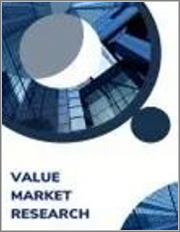
|
시장보고서
상품코드
1344549
척수 자극(SCS) 기기 시장 : 제품별, 적응증별, 최종사용자별 - 세계 기회 분석 및 산업 예측(2023-2032년)Spinal Cord Stimulation Devices Market By Product, By Indication, By End User : Global Opportunity Analysis and Industry Forecast, 2023-2032 |
||||||
Allied Market Research가 발행한 최신 보고서에 따르면, 척수 자극(SCS) 기기 시장은 2022년 21억 달러로 평가되며 2023년부터 2032년까지 연평균 8.4% 성장하여 2032년에는 48억 달러에 달할 것으로 추정됩니다.

척수 자극 기기 시장의 성장을 이끄는 주요 요인은 만성 통증 질환을 앓고 있는 사람들의 수 증가, 척수 자극(SCS) 기기의 기술 발전, 척수 자극 기기 채택 증가 등입니다. 만성 통증은 척추 수술 후 통증 증후군(FBSS), 복합부위통증증후군(CRPS), 디스크 퇴행성 질환(DDD), 당뇨병성 신경병증과 같은 다양한 증상으로 인해 발생할 수 있습니다. 이러한 상태는 쇠약해져 삶의 질에 영향을 미칠 수 있으며 장기적인 관리가 필요합니다. 척수자극(SCS) 장치는 다른 치료법이 효과가 없는 만성 통증 질환을 앓고 있는 환자들에게 효과적인 치료 옵션으로 떠오르고 있습니다. 또한, 척수 자극(SCS) 기기는 척수에 전기 자극을 보내 뇌로 전달되는 통증 신호를 차단하는 방식으로 작동합니다.
또한, 척수 자극(SCS) 기기의 기술 발전으로 장비의 크기가 작아지고, 유연해지고, 더 효과적이 되었습니다. 예를 들어, 새로운 장비는 고주파 자극을 사용하여 기존의 저주파 자극과 관련된 따끔거림과 따끔거림을 유발하지 않고 통증을 완화할 수 있습니다. 또한, 충전식 배터리와 무선 장비의 개발 등 다른 발전으로 환자의 편안함과 편의성이 향상되고 있습니다. 환자와 의사가 보다 효과적이고 사용하기 쉬운 기기를 찾는 가운데, 이러한 기술 발전은 척수 자극(SCS) 기기의 수요를 촉진할 것으로 예상됩니다.
또한 전 세계 인구는 빠르게 고령화되고 있으며, 이러한 인구 통계학적 변화는 척수 자극(SCS) 기기에 대한 수요를 촉진할 것으로 예상됩니다. 노인들은 만성 통증 질환에 시달릴 가능성이 높으며, 인구의 고령화에 따라 척수 자극 요법을 필요로 하는 사람들의 수가 증가할 것으로 예상됩니다. 예를 들어, 미국 인구조사국(2022년)에 따르면, 미국에는 65세 이상 성인이 5,600만 명 이상 거주하고 있으며, 이는 미국 인구의 약 16.9%를 차지합니다.
목차
제1장 서론
제2장 주요 요약
제3장 시장 개요
- 시장 정의와 범위
- 주요 조사 결과
- 영향요인
- 주요 투자 기회
- Porter's Five Forces 분석
- 공급 기업의 교섭력
- 구매자의 교섭력
- 대체품의 위협
- 신규 참여업체의 위협
- 경쟁의 강도
- 시장 역학
- 성장 촉진요인
- 만성 통증 질환 증가
- 척수 자극(SCS) 기기의 기술적 진보
- 의료 상환 제도 이용 가능성
- 성장 억제요인
- 척수 자극(SCS) 기기의 고비용과 부작용
- 만성 통증에 대한 대체 치료법 이용 가능성
- 기회
- 신흥 시장의 성장 기회
- 성장 촉진요인
- COVID-19 : 시장에 대한 영향 분석
제4장 척수 자극(SCS) 기기 시장 : 제품별
- 개요
- 충전식
- 비충전식
제5장 척수 자극(SCS) 기기 시장 : 적응증별
- 개요
- 척추 수술 후 통증 증후군(FBSS)
- 복합부위 통증 증후군(CRPS)
- 퇴행성 디스크 질환(DDD)
- 기타
제6장 척수 자극(SCS) 기기 시장 : 최종사용자별
- 개요
- 병원
- 외래 수술 센터
- 기타
제7장 척수 자극(SCS) 기기 시장 : 지역별
- 개요
- 북미
- 미국
- 캐나다
- 멕시코
- 유럽
- 독일
- 프랑스
- 영국
- 이탈리아
- 스페인
- 기타 유럽
- 아시아태평양
- 일본
- 중국
- 인도
- 호주
- 한국
- 기타 아시아태평양
- 라틴아메리카
- 라틴아메리카
- 중동 아프리카
제8장 경쟁 상황
- 서론
- 주요 성공 전략
- 주요 10개사 제품 매핑
- 경쟁 대시보드
- 경쟁 히트맵
- 주요 기업의 포지셔닝, 2022년
제9장 기업 개요
- Boston Scientific Corporation
- Medtronic plc
- Abbott Laboratories
- Nevro Corporation
- Beijing PINS Medical Co., Ltd
- Saluda Medical Pty Ltd.
- Nalu Medical, Inc.
- Teliatry, Inc.
- GIMER MEDICAL
- BIOTRONIK SE & Co. KG
According to a new report published by Allied Market Research, titled, "Spinal Cord Stimulation Devices Market," The spinal cord stimulation devices market was valued at $2.1 billion in 2022, and is estimated to reach $4.8 billion by 2032, growing at a CAGR of 8.4% from 2023 to 2032.

The major factors driving the growth of spinal cord stimulation devices market are increase in number of people suffering from chronic pain conditions, technological advancements in spinal cord stimulation devices, and rise in adoption of spinal cord stimulation devices. Chronic pain can be caused by a variety of conditions, such as failed back surgery syndrome (FBSS), complex regional pain syndrome (CRPS), degenerative disc disease (DDD), and diabetic neuropathy. These conditions can be debilitating, affecting a person's quality of life and requiring long-term management. Spinal cord stimulation devices have emerged as an effective treatment option for patients suffering from chronic pain conditions who have not responded to other forms of therapy. In addition, spinal cord stimulation devices work by delivering electrical impulses to the spinal cord, disrupting the transmission of pain signals to the brain.
Further, technological advancements in spinal cord stimulation devices have made the devices smaller, flexible, and more effective. For instance, newer devices use high-frequency stimulation, which can provide pain relief without causing the tingling or prickling sensations associated with traditional low-frequency stimulation. In addition, other advances include the development of rechargeable batteries and wireless devices, which improve patient comfort and convenience. These technological advancements are expected to drive the demand for spinal cord stimulation devices as patients and physicians seek out more effective and user-friendly devices.
Moreover, the world's population is aging rapidly, and this demographic shift is expected to drive the demand for spinal cord stimulation devices. Older adults are more likely to suffer from chronic pain conditions, and as the population ages, the number of people in need of spinal cord stimulation therapy is expected to grow. For instance, according to the U.S. Census Bureau 2022, more than 56 million adults aged 65 and older live in the U.S., accounting for about 16.9% of the nation's population; thus, rise in geriatric population is anticipated to fuel the growth of market.
The spinal cord stimulation devices market is segmented into product, indication, end user, and region. On the basis of product, the market is bifurcated into rechargeable devices and non-rechargeable devices. Depending on indication, it is categorized into failed back surgery syndrome, complex regional pain syndrome, degenerative disc disease, and others. By end user, it is segregated into hospital, ambulatory surgical centers, and others. Region wise, the market is analyzed across North America (the U.S., Canada, and Mexico), Europe (Germany, France, the UK, Italy, Spain, and rest of Europe), Asia-Pacific (Japan, China, Australia, India, South Korea, and rest of Asia-Pacific), and LAMEA (Latin America and Middle East Africa)
Major key players that operate in the global spinal cord stimulation devices market are Medtronic Plc, Boston Scientific Corporation, Abbott Laboratories, Nevro Corporation, Beijing PINS Medical Co., Ltd, Saluda Medical Pty Ltd., Nalu Medical, Inc., BIOTRONIK, GIMER MEDICAL, and Teliatry, Inc. The key players have adopted strategies such as acquisition, product launch, product approval, and expansion to expand their product portfolio.
Key Benefits For Stakeholders
- This report provides a quantitative analysis of the market segments, current trends, estimations, and dynamics of the spinal cord stimulation devices market analysis from 2022 to 2032 to identify the prevailing spinal cord stimulation devices market opportunities.
- The market research is offered along with information related to key drivers, restraints, and opportunities.
- Porter's five forces analysis highlights the potency of buyers and suppliers to enable stakeholders make profit-oriented business decisions and strengthen their supplier-buyer network.
- In-depth analysis of the spinal cord stimulation devices market segmentation assists to determine the prevailing market opportunities.
- Major countries in each region are mapped according to their revenue contribution to the global market.
- Market player positioning facilitates benchmarking and provides a clear understanding of the present position of the market players.
- The report includes the analysis of the regional as well as global spinal cord stimulation devices market trends, key players, market segments, application areas, and market growth strategies.
Key Market Segments
By Indication
- Failed back surgery syndrome
- Complex regional pain syndrome
- Degenerative disc disease
- Others
By Product
- Rechargeable devices
- Non-rechargeable devices
By End User
- Hospitals
- Ambulatory surgical centers
- Others
By Region
- North America
- U.S.
- Canada
- Mexico
- Europe
- Germany
- France
- UK
- Italy
- Spain
- Rest of Europe
- Asia-Pacific
- Japan
- China
- India
- Australia
- South Korea
- Rest of Asia-Pacific
- LAMEA
- Latin America
- Middle East Africa
Key Market Players:
- Boston Scientific Corporation
- Beijing PINS Medical Co., Ltd
- Medtronic plc
- Abbott Laboratories
- BIOTRONIK SE & Co. KG
- Saluda Medical Pty Ltd.
- Nalu Medical, Inc.
- GIMER MEDICAL
- Teliatry, Inc.
- Nevro Corporation
TABLE OF CONTENTS
CHAPTER 1: INTRODUCTION
- 1.1. Report description
- 1.2. Key market segments
- 1.3. Key benefits to the stakeholders
- 1.4. Research Methodology
- 1.4.1. Primary research
- 1.4.2. Secondary research
- 1.4.3. Analyst tools and models
CHAPTER 2: EXECUTIVE SUMMARY
- 2.1. CXO Perspective
CHAPTER 3: MARKET OVERVIEW
- 3.1. Market definition and scope
- 3.2. Key findings
- 3.2.1. Top impacting factors
- 3.2.2. Top investment pockets
- 3.3. Porter's five forces analysis
- 3.3.1. Bargaining power of suppliers
- 3.3.2. Bargaining power of buyers
- 3.3.3. Threat of substitutes
- 3.3.4. Threat of new entrants
- 3.3.5. Intensity of rivalry
- 3.4. Market dynamics
- 3.4.1. Drivers
- 3.4.1.1. Increase in prevalence of chronic pain conditions
- 3.4.1.2. Technological advancements in spinal cord stimulation devices
- 3.4.1.3. Availability of medical reimbursement schemes
- 3.4.1. Drivers
- 3.4.2. Restraints
- 3.4.2.1. High cost and side effects of spinal cord stimulation devices
- 3.4.2.2. Availability of alternative treatment options for chronic pain
- 3.4.3. Opportunities
- 3.4.3.1. Growth opportunities in emerging markets
- 3.5. COVID-19 Impact Analysis on the market
CHAPTER 4: SPINAL CORD STIMULATION DEVICES MARKET, BY PRODUCT
- 4.1. Overview
- 4.1.1. Market size and forecast
- 4.2. Rechargeable devices
- 4.2.1. Key market trends, growth factors and opportunities
- 4.2.2. Market size and forecast, by region
- 4.2.3. Market share analysis by country
- 4.3. Non-rechargeable devices
- 4.3.1. Key market trends, growth factors and opportunities
- 4.3.2. Market size and forecast, by region
- 4.3.3. Market share analysis by country
CHAPTER 5: SPINAL CORD STIMULATION DEVICES MARKET, BY INDICATION
- 5.1. Overview
- 5.1.1. Market size and forecast
- 5.2. Failed back surgery syndrome
- 5.2.1. Key market trends, growth factors and opportunities
- 5.2.2. Market size and forecast, by region
- 5.2.3. Market share analysis by country
- 5.3. Complex regional pain syndrome
- 5.3.1. Key market trends, growth factors and opportunities
- 5.3.2. Market size and forecast, by region
- 5.3.3. Market share analysis by country
- 5.4. Degenerative disc disease
- 5.4.1. Key market trends, growth factors and opportunities
- 5.4.2. Market size and forecast, by region
- 5.4.3. Market share analysis by country
- 5.5. Others
- 5.5.1. Key market trends, growth factors and opportunities
- 5.5.2. Market size and forecast, by region
- 5.5.3. Market share analysis by country
CHAPTER 6: SPINAL CORD STIMULATION DEVICES MARKET, BY END USER
- 6.1. Overview
- 6.1.1. Market size and forecast
- 6.2. Hospitals
- 6.2.1. Key market trends, growth factors and opportunities
- 6.2.2. Market size and forecast, by region
- 6.2.3. Market share analysis by country
- 6.3. Ambulatory surgical centers
- 6.3.1. Key market trends, growth factors and opportunities
- 6.3.2. Market size and forecast, by region
- 6.3.3. Market share analysis by country
- 6.4. Others
- 6.4.1. Key market trends, growth factors and opportunities
- 6.4.2. Market size and forecast, by region
- 6.4.3. Market share analysis by country
CHAPTER 7: SPINAL CORD STIMULATION DEVICES MARKET, BY REGION
- 7.1. Overview
- 7.1.1. Market size and forecast By Region
- 7.2. North America
- 7.2.1. Key trends and opportunities
- 7.2.2. Market size and forecast, by Product
- 7.2.3. Market size and forecast, by Indication
- 7.2.4. Market size and forecast, by End User
- 7.2.5. Market size and forecast, by country
- 7.2.5.1. U.S.
- 7.2.5.1.1. Key market trends, growth factors and opportunities
- 7.2.5.1.2. Market size and forecast, by Product
- 7.2.5.1.3. Market size and forecast, by Indication
- 7.2.5.1.4. Market size and forecast, by End User
- 7.2.5.2. Canada
- 7.2.5.2.1. Key market trends, growth factors and opportunities
- 7.2.5.2.2. Market size and forecast, by Product
- 7.2.5.2.3. Market size and forecast, by Indication
- 7.2.5.2.4. Market size and forecast, by End User
- 7.2.5.3. Mexico
- 7.2.5.3.1. Key market trends, growth factors and opportunities
- 7.2.5.3.2. Market size and forecast, by Product
- 7.2.5.3.3. Market size and forecast, by Indication
- 7.2.5.3.4. Market size and forecast, by End User
- 7.3. Europe
- 7.3.1. Key trends and opportunities
- 7.3.2. Market size and forecast, by Product
- 7.3.3. Market size and forecast, by Indication
- 7.3.4. Market size and forecast, by End User
- 7.3.5. Market size and forecast, by country
- 7.3.5.1. Germany
- 7.3.5.1.1. Key market trends, growth factors and opportunities
- 7.3.5.1.2. Market size and forecast, by Product
- 7.3.5.1.3. Market size and forecast, by Indication
- 7.3.5.1.4. Market size and forecast, by End User
- 7.3.5.2. France
- 7.3.5.2.1. Key market trends, growth factors and opportunities
- 7.3.5.2.2. Market size and forecast, by Product
- 7.3.5.2.3. Market size and forecast, by Indication
- 7.3.5.2.4. Market size and forecast, by End User
- 7.3.5.3. UK
- 7.3.5.3.1. Key market trends, growth factors and opportunities
- 7.3.5.3.2. Market size and forecast, by Product
- 7.3.5.3.3. Market size and forecast, by Indication
- 7.3.5.3.4. Market size and forecast, by End User
- 7.3.5.4. Italy
- 7.3.5.4.1. Key market trends, growth factors and opportunities
- 7.3.5.4.2. Market size and forecast, by Product
- 7.3.5.4.3. Market size and forecast, by Indication
- 7.3.5.4.4. Market size and forecast, by End User
- 7.3.5.5. Spain
- 7.3.5.5.1. Key market trends, growth factors and opportunities
- 7.3.5.5.2. Market size and forecast, by Product
- 7.3.5.5.3. Market size and forecast, by Indication
- 7.3.5.5.4. Market size and forecast, by End User
- 7.3.5.6. Rest of Europe
- 7.3.5.6.1. Key market trends, growth factors and opportunities
- 7.3.5.6.2. Market size and forecast, by Product
- 7.3.5.6.3. Market size and forecast, by Indication
- 7.3.5.6.4. Market size and forecast, by End User
- 7.4. Asia-Pacific
- 7.4.1. Key trends and opportunities
- 7.4.2. Market size and forecast, by Product
- 7.4.3. Market size and forecast, by Indication
- 7.4.4. Market size and forecast, by End User
- 7.4.5. Market size and forecast, by country
- 7.4.5.1. Japan
- 7.4.5.1.1. Key market trends, growth factors and opportunities
- 7.4.5.1.2. Market size and forecast, by Product
- 7.4.5.1.3. Market size and forecast, by Indication
- 7.4.5.1.4. Market size and forecast, by End User
- 7.4.5.2. China
- 7.4.5.2.1. Key market trends, growth factors and opportunities
- 7.4.5.2.2. Market size and forecast, by Product
- 7.4.5.2.3. Market size and forecast, by Indication
- 7.4.5.2.4. Market size and forecast, by End User
- 7.4.5.3. India
- 7.4.5.3.1. Key market trends, growth factors and opportunities
- 7.4.5.3.2. Market size and forecast, by Product
- 7.4.5.3.3. Market size and forecast, by Indication
- 7.4.5.3.4. Market size and forecast, by End User
- 7.4.5.4. Australia
- 7.4.5.4.1. Key market trends, growth factors and opportunities
- 7.4.5.4.2. Market size and forecast, by Product
- 7.4.5.4.3. Market size and forecast, by Indication
- 7.4.5.4.4. Market size and forecast, by End User
- 7.4.5.5. South Korea
- 7.4.5.5.1. Key market trends, growth factors and opportunities
- 7.4.5.5.2. Market size and forecast, by Product
- 7.4.5.5.3. Market size and forecast, by Indication
- 7.4.5.5.4. Market size and forecast, by End User
- 7.4.5.6. Rest of Asia-Pacific
- 7.4.5.6.1. Key market trends, growth factors and opportunities
- 7.4.5.6.2. Market size and forecast, by Product
- 7.4.5.6.3. Market size and forecast, by Indication
- 7.4.5.6.4. Market size and forecast, by End User
- 7.5. LAMEA
- 7.5.1. Key trends and opportunities
- 7.5.2. Market size and forecast, by Product
- 7.5.3. Market size and forecast, by Indication
- 7.5.4. Market size and forecast, by End User
- 7.5.5. Market size and forecast, by country
- 7.5.5.1. Latin America
- 7.5.5.1.1. Key market trends, growth factors and opportunities
- 7.5.5.1.2. Market size and forecast, by Product
- 7.5.5.1.3. Market size and forecast, by Indication
- 7.5.5.1.4. Market size and forecast, by End User
- 7.5.5.2. Middle East Africa
- 7.5.5.2.1. Key market trends, growth factors and opportunities
- 7.5.5.2.2. Market size and forecast, by Product
- 7.5.5.2.3. Market size and forecast, by Indication
- 7.5.5.2.4. Market size and forecast, by End User
CHAPTER 8: COMPETITIVE LANDSCAPE
- 8.1. Introduction
- 8.2. Top winning strategies
- 8.3. Product Mapping of Top 10 Player
- 8.4. Competitive Dashboard
- 8.5. Competitive Heatmap
- 8.6. Top player positioning, 2022
CHAPTER 9: COMPANY PROFILES
- 9.1. Boston Scientific Corporation
- 9.1.1. Company overview
- 9.1.2. Key Executives
- 9.1.3. Company snapshot
- 9.1.4. Operating business segments
- 9.1.5. Product portfolio
- 9.1.6. Business performance
- 9.1.7. Key strategic moves and developments
- 9.2. Medtronic plc
- 9.2.1. Company overview
- 9.2.2. Key Executives
- 9.2.3. Company snapshot
- 9.2.4. Operating business segments
- 9.2.5. Product portfolio
- 9.2.6. Business performance
- 9.2.7. Key strategic moves and developments
- 9.3. Abbott Laboratories
- 9.3.1. Company overview
- 9.3.2. Key Executives
- 9.3.3. Company snapshot
- 9.3.4. Operating business segments
- 9.3.5. Product portfolio
- 9.3.6. Business performance
- 9.3.7. Key strategic moves and developments
- 9.4. Nevro Corporation
- 9.4.1. Company overview
- 9.4.2. Key Executives
- 9.4.3. Company snapshot
- 9.4.4. Operating business segments
- 9.4.5. Product portfolio
- 9.4.6. Business performance
- 9.4.7. Key strategic moves and developments
- 9.5. Beijing PINS Medical Co., Ltd
- 9.5.1. Company overview
- 9.5.2. Key Executives
- 9.5.3. Company snapshot
- 9.5.4. Operating business segments
- 9.5.5. Product portfolio
- 9.6. Saluda Medical Pty Ltd.
- 9.6.1. Company overview
- 9.6.2. Key Executives
- 9.6.3. Company snapshot
- 9.6.4. Operating business segments
- 9.6.5. Product portfolio
- 9.6.6. Key strategic moves and developments
- 9.7. Nalu Medical, Inc.
- 9.7.1. Company overview
- 9.7.2. Key Executives
- 9.7.3. Company snapshot
- 9.7.4. Operating business segments
- 9.7.5. Product portfolio
- 9.8. Teliatry, Inc.
- 9.8.1. Company overview
- 9.8.2. Key Executives
- 9.8.3. Company snapshot
- 9.8.4. Operating business segments
- 9.8.5. Product portfolio
- 9.9. GIMER MEDICAL
- 9.9.1. Company overview
- 9.9.2. Key Executives
- 9.9.3. Company snapshot
- 9.9.4. Operating business segments
- 9.9.5. Product portfolio
- 9.9.6. Key strategic moves and developments
- 9.10. BIOTRONIK SE & Co. KG
- 9.10.1. Company overview
- 9.10.2. Key Executives
- 9.10.3. Company snapshot
- 9.10.4. Operating business segments
- 9.10.5. Product portfolio
- 9.10.6. Key strategic moves and developments



















